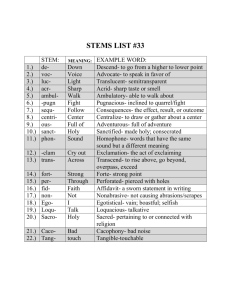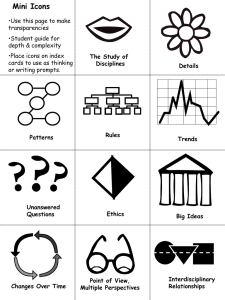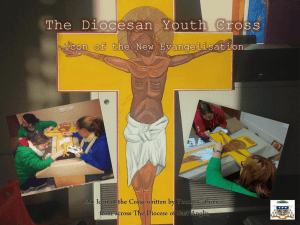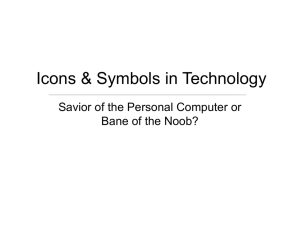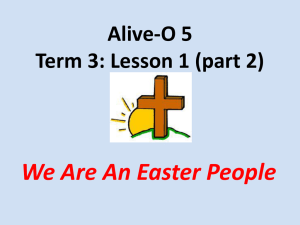St. Cosmas the Hymnographer - St. Gregory of Nyssa Orthodox
advertisement
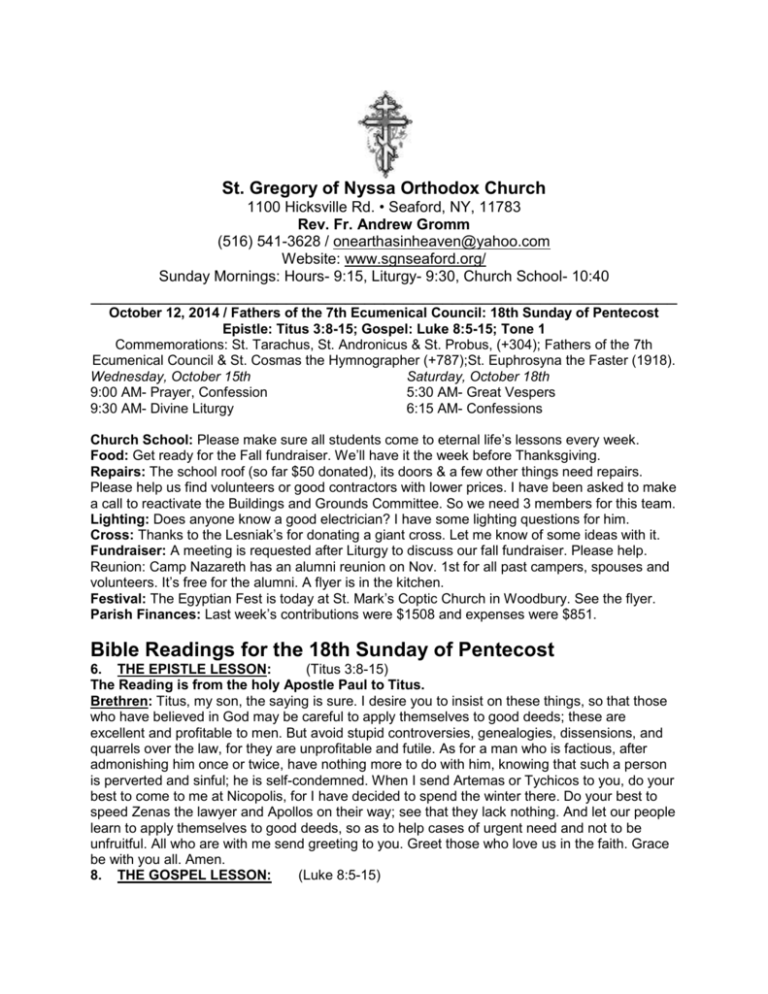
St. Gregory of Nyssa Orthodox Church 1100 Hicksville Rd. • Seaford, NY, 11783 Rev. Fr. Andrew Gromm (516) 541-3628 / onearthasinheaven@yahoo.com Website: www.sgnseaford.org/ Sunday Mornings: Hours- 9:15, Liturgy- 9:30, Church School- 10:40 ____________________________________________________________ October 12, 2014 / Fathers of the 7th Ecumenical Council: 18th Sunday of Pentecost Epistle: Titus 3:8-15; Gospel: Luke 8:5-15; Tone 1 Commemorations: St. Tarachus, St. Andronicus & St. Probus, (+304); Fathers of the 7th Ecumenical Council & St. Cosmas the Hymnographer (+787);St. Euphrosyna the Faster (1918). Wednesday, October 15th Saturday, October 18th 9:00 AM- Prayer, Confession 5:30 AM- Great Vespers 9:30 AM- Divine Liturgy 6:15 AM- Confessions Church School: Please make sure all students come to eternal life’s lessons every week. Food: Get ready for the Fall fundraiser. We’ll have it the week before Thanksgiving. Repairs: The school roof (so far $50 donated), its doors & a few other things need repairs. Please help us find volunteers or good contractors with lower prices. I have been asked to make a call to reactivate the Buildings and Grounds Committee. So we need 3 members for this team. Lighting: Does anyone know a good electrician? I have some lighting questions for him. Cross: Thanks to the Lesniak’s for donating a giant cross. Let me know of some ideas with it. Fundraiser: A meeting is requested after Liturgy to discuss our fall fundraiser. Please help. Reunion: Camp Nazareth has an alumni reunion on Nov. 1st for all past campers, spouses and volunteers. It’s free for the alumni. A flyer is in the kitchen. Festival: The Egyptian Fest is today at St. Mark’s Coptic Church in Woodbury. See the flyer. Parish Finances: Last week’s contributions were $1508 and expenses were $851. Bible Readings for the 18th Sunday of Pentecost 6. THE EPISTLE LESSON: (Titus 3:8-15) The Reading is from the holy Apostle Paul to Titus. Brethren: Titus, my son, the saying is sure. I desire you to insist on these things, so that those who have believed in God may be careful to apply themselves to good deeds; these are excellent and profitable to men. But avoid stupid controversies, genealogies, dissensions, and quarrels over the law, for they are unprofitable and futile. As for a man who is factious, after admonishing him once or twice, have nothing more to do with him, knowing that such a person is perverted and sinful; he is self-condemned. When I send Artemas or Tychicos to you, do your best to come to me at Nicopolis, for I have decided to spend the winter there. Do your best to speed Zenas the lawyer and Apollos on their way; see that they lack nothing. And let our people learn to apply themselves to good deeds, so as to help cases of urgent need and not to be unfruitful. All who are with me send greeting to you. Greet those who love us in the faith. Grace be with you all. Amen. 8. THE GOSPEL LESSON: (Luke 8:5-15) Let Us Be Attentive: At that time, the Lord told this parable: “The sower went out to sow his seed. And as he sowed, some seed fell by the wayside & was trodden underfoot, and the birds of the air ate it up. And other seed fell upon the rock & as soon as it had sprung up it withered away because it had no moisture. And other seed fell among thorns, and the thorns sprang up with it & choked it. And other seed fell upon good ground & sprang up & yielded fruit a hundredfold.” As he said these things he cried out, “He who has ears to hear, let him hear.” but his disciples then began to ask him what this parable meant. He said to them, “To you it is given to know the mystery of the kingdom of God, but to the rest in parables, that ‘Seeing they may not see & hearing they may not understand.’ Now the parable is this: the seed is the word of God and those by the wayside are they who have heard. Then the devil comes & takes away the word from their heart, that they may not believe & be saved. Now those upon the rock are they who, when they have heard, receive the word with joy. And these have no root, but believe for a while, and in time of temptation fall away. And that which fell among the thorns, these are they who have heard & as they go their way are choked by the cares & riches & pleasures of life, and their fruit does not ripen. But that upon good ground, these are they who, with a right & good heart, having heard the word, hold it fast, and bear fruit in patience.” When he had said this, he cried out, “He who has ears to hear, let him hear.” Extra Lessons from Priestly Sources A Passage of the Prologue from Ochrid for October 12th “Heaviness may endure for a night, but joy comes in the morning.” (Psalm 29:6) These words mean that the night is for tears and prayers, for repentance and meditation. If a man weeps in penitence at night, he will rejoice in the day-time, rejoice as one new-born, as one redeemed, as one freed from the burden of sin. If he spends the night in sin and mindless merrymaking, day will dawn for him in grief and lamentation. Fr. Andrew’s commentary on the passage above: The passage above also relates to our lives. If we focus too much on earthly cares, financial rights and entertainment, we will be in grief & lamentation, in agitation & anger, since the self can’t get everything it wants in life. It is a life of misery when the self can’t be absorbed enough. I like its phrase about spending “the night in sin and mindless merrymaking”. There is a merrymaking that isn’t mindless, which used to occur regularly before our culture became so officially regulated. In the movie “Moby Dick”, there is a scene of tough guys in a tavern, who suddenly get up & sing heartily, doing jigs arm in arm. Such spontaneity comes from the old village spirit of community and amity. No one was lonely in this life of innocent merrymaking, which was a meaningful complement to man’s quest for godly love. But there is loneliness in modern man. He doesn’t suddenly do a friendly jig. He doesn’t sing at work or at church. He doesn’t rejoice over anything meaningful. Everything around him is now a source of “grief & lamentation” because he no longer repents and meditates on godliness. He constantly watches entertaining shows & songs on TV & the radio, a mindless merrymaking, not only at night, but all day long, never reminding us of God & Church, but simply makes noise. All this ruins the good soil of the soul that God created for us. The pop-culture mentality is the seeds in Christ’s parable that fell and withered on rocks & thorns, seeds that were eaten up. The good soil is Liturgy, prayer, repentance, meditation and remembering God among us. It is the presence of the Church that brings joy because it is here that merrymaking is truly mindful. Iconic Miracles The Kaluga Icon of the Mother of God appeared in the year 1748. In 1812 many Russian and French soldiers beheld the Kaluga icon of the Mother of God, standing in the air. Thus also it was around Kaluga and Maloyaroslavl. During such appearances the Russian armies were always victorious. This vision was also granted to the peasant Paraskeva Alekseeva. The Yaroslav-Smolensk Icon of the Mother of God was the cell icon of the archimandrite of the Trinity-St Sergius Lavra, Anthony. On October 12, 1642 while he was praying, he heard a voice from the Smolensk Hodigitria (Directress) icon saying, “Go, go to the limits of the city of Yaroslavl, to a newly-made monastery in My name.” Archimandrite Anthony sent this icon with the Venerable Gersaim to the indicated monastery, being built in the forest, not far from Yaroslavl’. The wonderworking icon was set in the monastery church in the altar area. St. Tarachus, St. Probus and St. Andronicus The Martyrs Tarachus, Probus, and Andronicus suffered for Christ in the year 304 at Tarsus in Cilicia. When the pagans ordered him to offer sacrifice to idols, the old soldier Tarachus replied that he would offer a pure heart to the one true God instead of sacrifices of blood. Seeing the firmness of the saint’s confession the true Faith, the proconsul gave them all over to torture. “When my body suffers,” St Probus said to the idol worshippers, “then my soul is healed and invigorated.” The tormentors refined their tortures, such as their rage could invent, and then they tore the bodies of the saints apart. Christians secretly took up the saints’ relics and buried them. The tormentors subjected the martyrs to various tortures, and then they tore the bodies of the saints apart. Christians secretly took up the relics of the saints and buried them. St. Cosmas the Hymnographer Saint Cosmas the Hymnographer, Bishop of Maiuma, was a native of Jerusalem. He was raised by the parents of St John of Damascus together with their son, and he received a fine education. When St Cosmas came of age, he set out to one of the monasteries of Palestine, where he attained reknown for his monastic exploits. During a time of persecution against holy icons St Cosmas, and the venerable John, came forward to defend Orthodoxy. In the year 743 Cosmas was made Bishop of Maiuma. He died in old age, leaving behind many canons for feast days and a Triodion for four days of Holy Week. The Holy Fathers of the 7th Ecumenical Council Today the Church remembers the 350 holy Fathers of the Seventh Ecumenical Council under the holy Patriarch Tarasius. The Synod of 787, the second to meet at Nicea, refuted the Iconoclast heresy during the reign of Empress Irene and her son Constantine Porphyrogenitos. The Council decreed that the veneration of icons was not idolatry (Exodus 20:4-5), because the honor shown to them is not directed to the wood or paint, but passes to the prototype (the person depicted). It also upheld the possibility of depicting Christ, Who became man and took flesh at His Incarnation. The Father, on the other hand, cannot be represented in His eternal nature, because “no man has seen God at any time” (John 1:18). The Holy Fathers of the 7th Ecumenical Council The Iconoclast Controversy centered around the use of icons in the Church & the controversy between the iconoclasts and iconophiles. The Iconoclasts were suspicious of religious art; they demanded that the Church rid itself of such art and that it be destroyed or broken (as the term "iconoclast" implies). The iconophiles believed that icons served to preserve the doctrinal teachings of the Church. They considered icons to be man's dynamic way of expressing the divine through art & beauty. The Iconoclast controversy was a form of Monophysitism: distrust & degrading of the human. The council in 787 had 367 bishops present, who proclaimed, "We define that the holy icons, whether in color, mosaic, or some other material, should be exhibited in the holy churches of God, on the sacred vessels and liturgical vestments, on the walls, furnishings, and in houses and along the roads, namely the icons of our Lord God & Savior Jesus Christ, that of our Lady the Theotokos, those of the venerable angels and those of all saintly people. Whenever these representations are contemplated, they will cause those who look at them to commemorate & love their prototype. We define also that they should be kissed and that they are an object of veneration and honor, but not of real worship, which is reserved for Him Who is the subject of our faith and is proper for the divine nature, ... which is in effect transmitted to the prototype; he who venerates the icon, venerated in it the reality for which it stands." St. John of Damascus (675-745) was educated at the Caliphate Court in Damascus. He held a position comparable to that of a Prime Minister. He was a devout Orthodox Christian. He entered the Monastery of St. Sabbas in Palestine, where he wrote many poems, hymns and treaties, one of which is called "An Exact Exposition of the Orthodox Faith." This work is a systematic theological summary of all the basic doctrines of the first seven centuries, a monumental work which became a classic in Orthodox Theology. A Regional Synod was called in Constantinople in 843 under Empress Theodora. The veneration of icons was solemnly proclaimed at the St. Sophia's Cathedral. Monks and clergy came in procession and restored the icons in their rightful place. The day was called "Triumph of Orthodoxy." Since that time, this event is commemorated yearly with a special service on the first Sunday of Lent, the "Sunday of Orthodoxy."
